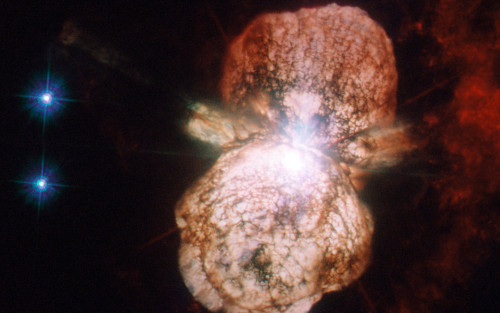Mathematicians Bridge Finite-Infinite Divide


Fascinating, even if you are unable to grasp the mathematical depths, details are for professional thinkers on the field, enjoy the surface, is pretty enjoyable too.
Mathematicians Bridge Finite-Infinite Divide
A surprising new proof is helping to connect the mathematics of infinity to the physical world. (Quanta Magazine)
Images by Lucy Reading-Ikkanda
More Posts from Science-is-magical and Others
A guy asks an engineer “hey what 2 + 2?”
Engineer responds “4. No wait make 5 just to be on the safe side.”






Happy TRAPPIST-1 Day!
Here’s a comic on our latest discovery!
http://www.space.com/35806-trappist-1-facts.html

Redrawing the brain’s motor map
Neuroscientists at Emory have refined a map showing which parts of the brain are activated during head rotation, resolving a decades-old puzzle. Their findings may help in the study of movement disorders affecting the head and neck, such as cervical dystonia and head tremor.
The results were published in Journal of Neuroscience.
In landmark experiments published in the 1940s and 50s, Canadian neurosurgeon Wilder Penfield and colleagues determined which parts of the motor cortex controlled the movements of which parts of the body.
Penfield stimulated the brain with electricity in patients undergoing epilepsy surgery, and used the results to draw a “motor homunculus”: a distorted representation of the human body within the brain. Penfield assigned control of the neck muscles to a region between those that control the fingers and face, a finding inconsistent with some studies that came later.
Using modern functional MRI (magnetic resonance imaging), researchers at Emory University School of Medicine have shown that the neck’s motor control region in the brain is actually between the shoulders and trunk, a location that more closely matches the arrangement of the body itself.
“We can’t be that hard on Penfield, because the number of cases where he was able to study head movement was quite limited, and studying head motion as he did, by applying an electrode directly to the brain, creates some challenges,” says lead author Buz Jinnah, MD, professor of neurology, human genetics and pediatrics at Emory University School of Medicine.
The new location for the neck muscles makes more sense, because it corresponds to a similar map Penfield established of the sense of touch (the somatosensory cortex), Jinnah says.
Participants in brain imaging studies need to keep their heads still to provide accurate data, so volunteers were asked to perform isometric muscle contraction. They attempted to rotate their heads to the left or the right, even though head movement was restricted by foam padding and restraining straps.
First author Cecilia Prudente, a graduate student in neuroscience who is now a postdoctoral associate at the University of Minnesota, developed the isometric head movement task and obtained internal funding that allowed the study to proceed.
She and Jinnah knew that isometric exercises for the wrist activated the same regions of the motor cortex as wrist movements, and used that as a reference point in their study. During brain imaging, they were able to check that particular muscles were being tensed by directly monitoring volunteers’ muscles electronically.
When volunteers contracted their neck muscles, researchers were able to detect activation in other parts of the brain too, such as the cerebellum and the basal ganglia, which are known to be involved in movement control. This comes as no surprise, Jinnah says, since these regions also control movements of the hands and other body parts.
Prudente, Jinnah and colleagues have conducted a similar study with cervical dystonia patients, with the goal of comparing the patterns of brain activation between healthy volunteers and the patients. Cervical dystonia is a painful condition in which the neck muscles contract involuntarily and the head posture is distorted.
“These results may help guide future studies in humans and animals, as well as medical or surgical interventions for cervical dystonia and other disorders involving abnormal head movements,” Prudente says.

The folks over at NASA just featured this nifty infographic on APOD about detecting objects in the sky:
How to Identify that Light in the Sky
What is that light in the sky?
Perhaps one of humanity’s more common questions, an answer may result from a few quick observations.
Image: HK (The League of Lost Causes)
For example — is it moving or blinking? If so, and if you live near a city, the answer is typically an airplane, since planes are so numerous and so few stars and satellites are bright enough to be seen over the din of artificial city lights.
If not, and if you live far from a city, that bright light is likely a planet such as Venus or Mars — the former of which is constrained to appear near the horizon just before dawn or after dusk.
Sometimes the low apparent motion of a distant airplane near the horizon makes it hard to tell from a bright planet, but even this can usually be discerned by the plane’s motion over a few minutes. Still unsure?
The above chart gives a sometimes-humorous but mostly-accurate assessment. Dedicated sky enthusiasts will likely note — and are encouraged to provide — polite corrections.

Oh hey, not a big deal, but the hubble took a picture of a star that’s nearing supernova status

English-speaking parents tend to use vague, one-size-fits-all verbs as they emphasize nouns: cars, trucks, buses, bicycles and scooters all simply “go.” Mandarin speakers do the opposite: they use catchall nouns such as “vehicle” but describe action—driving, riding, sitting on, pushing—with very specific verbs. “As a native English speaker, my first instinct when a baby points is to label,” Tardif says. Her babysitter, on the other hand, was a native Mandarin speaker, whose instinct was to name the action she thought the child was trying to achieve.
via Twitter
Just Made a Bad Decision?
Most people experience anxiety in their lives. For some, it is just a bad, passing feeling, but, for many, anxiety rules their day-to-day lives, even to the point of taking over the decisions they make.
Scientists at the University of Pittsburgh have discovered a mechanism for how anxiety may disrupt decision making. In a study published in The Journal of Neuroscience, they report that anxiety disengages a region of the brain called the prefrontal cortex (PFC), which is critical for flexible decision making. By monitoring the activity of neurons in the PFC while anxious rats had to make decisions about how to get a reward, the scientists made two observations. First, anxiety leads to bad decisions when there are conflicting distractors present. Second, bad decisions under anxiety involve numbing of PFC neurons.
The data indicates that anxiety has an exquisitely selective effect on neuronal activity that supports decision making, says Bita Moghaddam, the lead author of the study and a professor in the Department of Neuroscience within the Kenneth P. Dietrich School of Arts and Sciences. Up to now, scientists have mostly studied anxiety in animal models in the context of fear and measured how brain cells react to a threatening situation. But human anxiety is devastating, not merely because of how the person feels, but also because it can interfere with nearly all aspects of daily life including decision making, Moghaddam says.
Pitt researchers studied this aspect of anxiety by monitoring the activity of a large number of neurons as rats made decisions about which choice was most optimal for receiving a reward. They compared behavior and neuronal activity in two groups: one group that had a placebo injection and another that got a low dose of an anxiety-inducing drug.
As with many people who suffer from anxiety but go through day-to-day life and make decisions, the anxious rats completed the decision-making task and, actually, did not do too badly. But they made far more mistakes when the correct choice involved ignoring distracting information. “A brain locus of vulnerability for these anxiety-induced mistakes was a group of cells in the PFC that specifically coded for choice. Anxiety weakened the coding power of these neurons.
“We have had a simplistic approach to studying and treating anxiety. We have equated it with fear and have mostly assumed that it over-engages entire brain circuits. But this study shows that anxiety disengages brain cells in a highly specialized manner.”
Perhaps, down the line, this better understanding of the brain mechanics behind anxiety and decision making, she says, could lead to better treatment of anxiety in people and, subsequently, better outcomes in the treatment of psychiatric disorders.
-
 haruatori liked this · 1 year ago
haruatori liked this · 1 year ago -
 theknottyprofessor liked this · 4 years ago
theknottyprofessor liked this · 4 years ago -
 the-dragonair-lair liked this · 8 years ago
the-dragonair-lair liked this · 8 years ago -
 flyingwithrabidturtles liked this · 8 years ago
flyingwithrabidturtles liked this · 8 years ago -
 opossumdaemon reblogged this · 8 years ago
opossumdaemon reblogged this · 8 years ago -
 warcrimesimulator reblogged this · 8 years ago
warcrimesimulator reblogged this · 8 years ago -
 archive-slfd liked this · 8 years ago
archive-slfd liked this · 8 years ago -
 science-is-magical reblogged this · 8 years ago
science-is-magical reblogged this · 8 years ago -
 alvarobernabe liked this · 8 years ago
alvarobernabe liked this · 8 years ago -
 theofficialslugby liked this · 8 years ago
theofficialslugby liked this · 8 years ago -
 provemebitch liked this · 8 years ago
provemebitch liked this · 8 years ago -
 comcombb reblogged this · 8 years ago
comcombb reblogged this · 8 years ago -
 transcendenz liked this · 8 years ago
transcendenz liked this · 8 years ago -
 drvij liked this · 8 years ago
drvij liked this · 8 years ago -
 skeptical020 liked this · 8 years ago
skeptical020 liked this · 8 years ago -
 filhodeumdeusmenor reblogged this · 8 years ago
filhodeumdeusmenor reblogged this · 8 years ago -
 filhodeumdeusmenor liked this · 8 years ago
filhodeumdeusmenor liked this · 8 years ago -
 sarayisthename liked this · 8 years ago
sarayisthename liked this · 8 years ago -
 porcelainphantom liked this · 8 years ago
porcelainphantom liked this · 8 years ago -
 redpanda25 reblogged this · 8 years ago
redpanda25 reblogged this · 8 years ago -
 britbeast liked this · 8 years ago
britbeast liked this · 8 years ago -
 no-words-for-iu liked this · 8 years ago
no-words-for-iu liked this · 8 years ago -
 tqhkzv liked this · 8 years ago
tqhkzv liked this · 8 years ago -
 cat-ai liked this · 8 years ago
cat-ai liked this · 8 years ago -
 ibruno-reis liked this · 8 years ago
ibruno-reis liked this · 8 years ago -
 vantasei liked this · 8 years ago
vantasei liked this · 8 years ago -
 bikabikachu liked this · 8 years ago
bikabikachu liked this · 8 years ago -
 arcticskyy liked this · 8 years ago
arcticskyy liked this · 8 years ago -
 bennswag-blog reblogged this · 8 years ago
bennswag-blog reblogged this · 8 years ago -
 bennswag-blog liked this · 8 years ago
bennswag-blog liked this · 8 years ago -
 wells-hg reblogged this · 8 years ago
wells-hg reblogged this · 8 years ago -
 plentyofintention reblogged this · 8 years ago
plentyofintention reblogged this · 8 years ago -
 quattrosurfer liked this · 8 years ago
quattrosurfer liked this · 8 years ago -
 truletters-blog reblogged this · 8 years ago
truletters-blog reblogged this · 8 years ago -
 samir92 liked this · 8 years ago
samir92 liked this · 8 years ago -
 theobserver00 liked this · 8 years ago
theobserver00 liked this · 8 years ago -
 deliriousmonkeythomas-blog liked this · 8 years ago
deliriousmonkeythomas-blog liked this · 8 years ago -
 squirrelofudun liked this · 8 years ago
squirrelofudun liked this · 8 years ago -
 babythickums6669-blog reblogged this · 8 years ago
babythickums6669-blog reblogged this · 8 years ago




